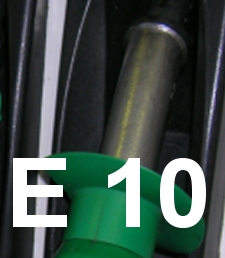E10
could be on sale in the UK from early 2013
At the end of June the motor fuel specialist at FBHVC, Matthew
Vincent, attended a meeting at the British Standards Institute
to discuss petrol labelling. There were a number of points
of particular interest to member organisations and their historic
and classic car members.
The earlier introduction of E10 discussed at the BSI
meeting "appears to contradict statements made by the DfT
earlier in 2012". More
Can I see more on biofuels?
See our Information Gateway on biofuels. More
Biofuel
terminology
The terms E5 and E10 refer to the proportion of ethanol in the
motor fuel sold at filling stations.
What is the FBHVC?
The Federation of British Historic Vehicle Clubs (FBHVC) is
a grouping of historic vehicle clubs and museums together with
some trade and Individual Supporters.
FBHVC website
Posted: 120801
Back to homepage
|
 |
Earlier
introduction of E10
At the BSI meeting it was revealed that E10 can
be sold in the UK as soon as the documentary work
has been completed. It is expected that this will
be achieved towards the end of 2012, so in theory
the product could be in petrol stations from the
first quarter of 2013. Exactly how much of this
grade arrives, and when, is not known yet, and this
situation appears to contradict statements made
by the Department for Transport earlier this year
at a |
DfT
meeting with classic car clubs. It was the belief
of those assembled that petrol containing 5% ethanol
would be retained until 2020, but it was also clear
that over time ethanol levels would rise above 10%
in order to meet EU legislation on renewable fuels.
It is envisaged that high octane unleaded petrol
(sometimes called 'super premium' and usually of
97-99 octane rating) would not contain more than
5% ethanol, and would remain as a protection grade
for the foreseeable future. DfT are expected to
publish a leaflet explaining what will be happening.
Labelling for E10
The labelling for E10 was discussed in detail at
the BSI meeting and it was agreed that the code
'E10' would feature prominently on the label,
being given the same size lettering (15mm) as the
words 'Unleaded Petrol' and the octane rating
(95). The warning to motorists about the
suitability or otherwise of the fuel will use smaller
lettering (10mm), but should still be clearly visible.
Despite apparent agreement at a previous meeting
of a different format, the form of wording shown
below was adopted: 'Not suitable for all vehicles.
Consult vehicle manufacturer before use'. This
might in theory cause some logistical problems for
owners of historic vehicles whose manufacturers
no longer exist, but in reality, unless actions
are taken by owners to proof their fuel systems
against the effects of E10, then it should be regarded
as unsuitable for any historic vehicle.
Unleaded petrol containing up to 5% ethanol will
not need to be labelled, but if the ethanol
content rises above 5%, the fuel must be labelled.
If the label on the petrol pump does not include
the code 'E10', then the fuel should contain no
more than 5% ethanol. So in effect there is a "by
default non labelling" on E5!
Volatility issues
The
proposed volatility limits of petrol containing
10% ethanol (E10) in the revised European specification
are likely to be agreed later this year. The inclusion
of 10% ethanol will be accompanied by an increase
in the permitted upper limit of volatility. Although
the change is small, in effect it means that petrol
with 10% ethanol will be more volatile than existing
petrol containing no ethanol, or with 5% ethanol
in a blend. This change will not assist owners
of historic vehicles fitted with carburettors,
but there has already been significant discussion
about in-situ alterations for vehicles suffering
from vapour lock in hot weather. The arrival of
E10 will probably require a renewed awareness of
modifications as attempt to remedy volatility related
issues. Full details about this are already on the
FBHVC
website. |
|
|

